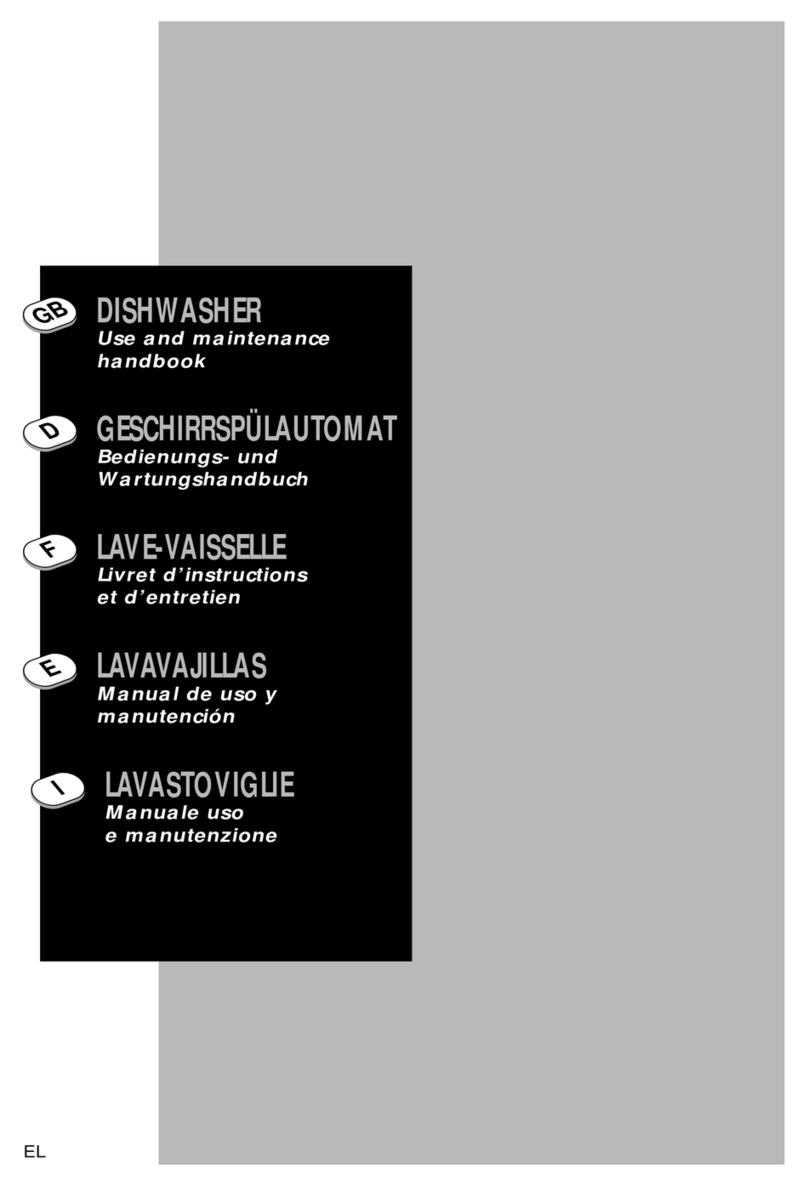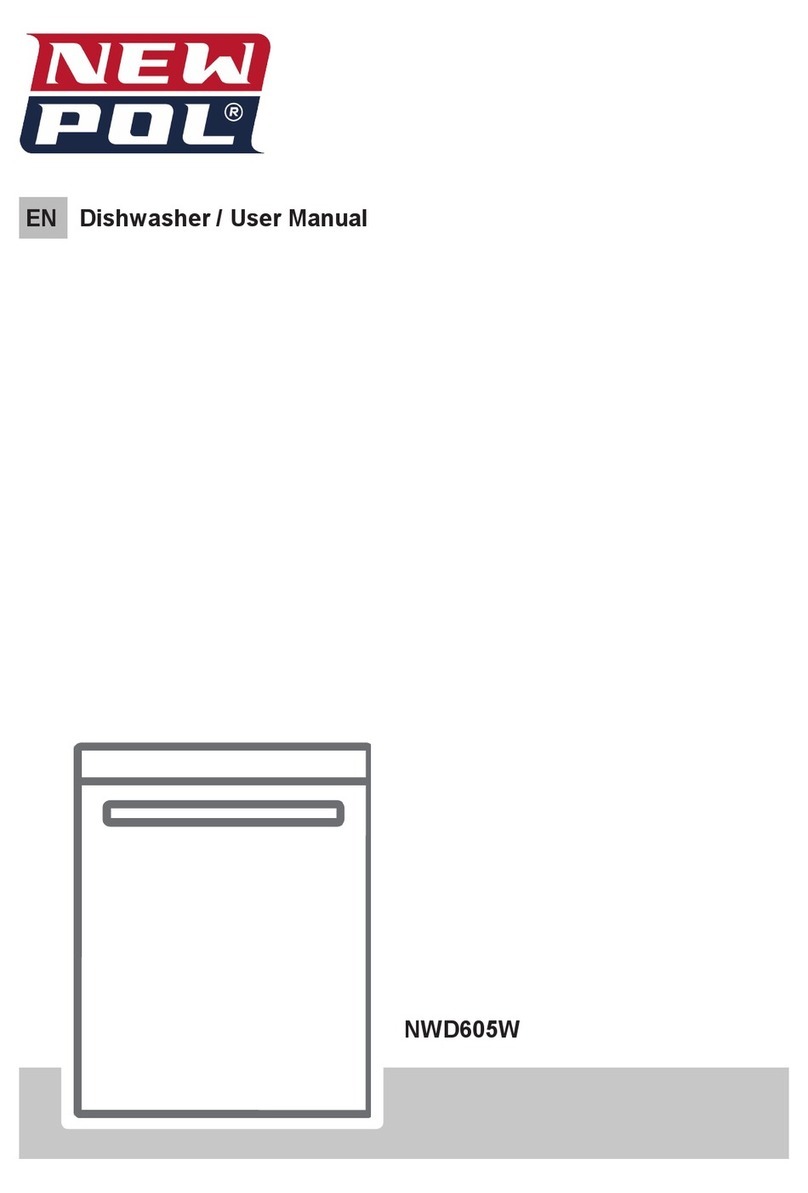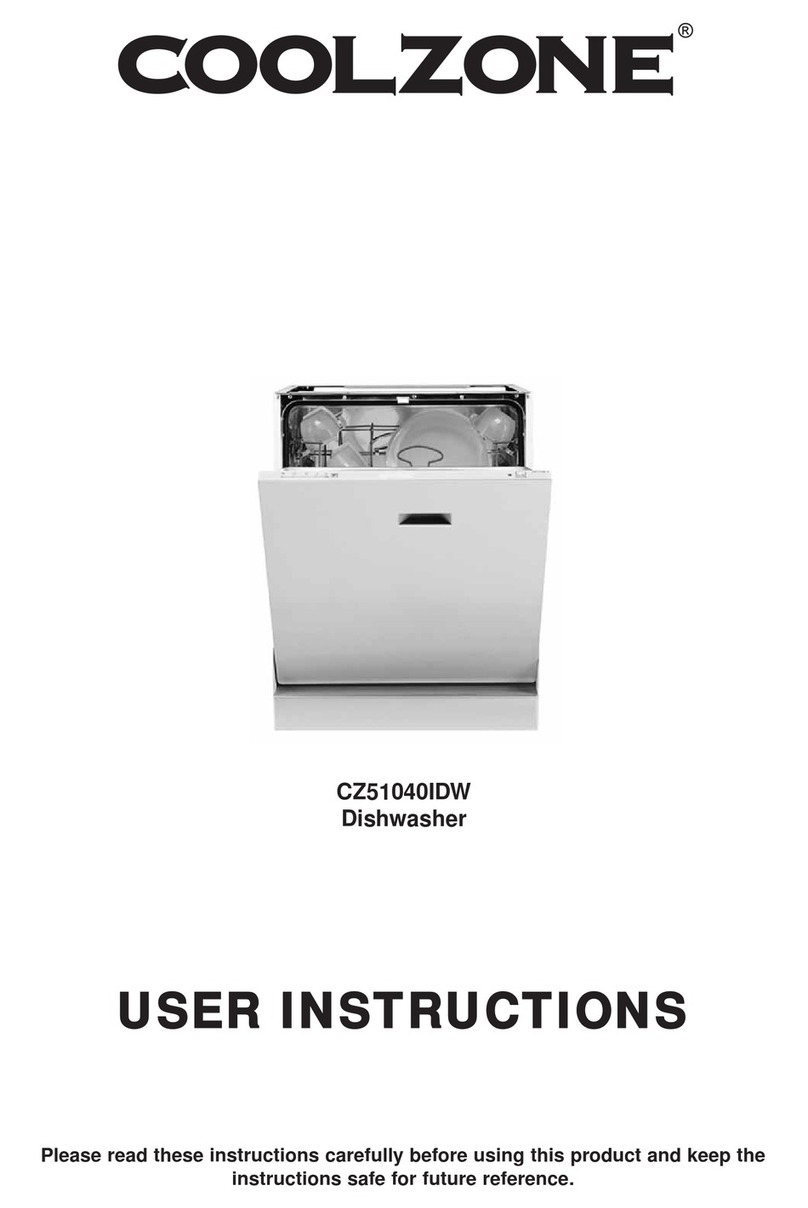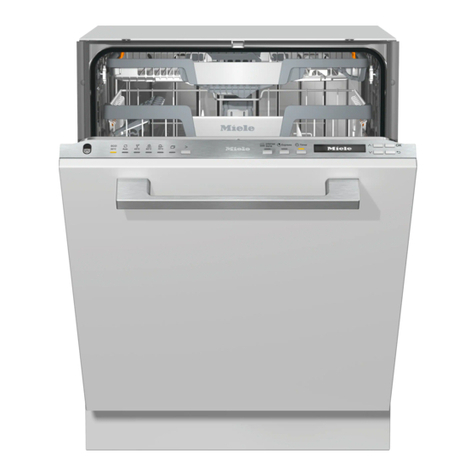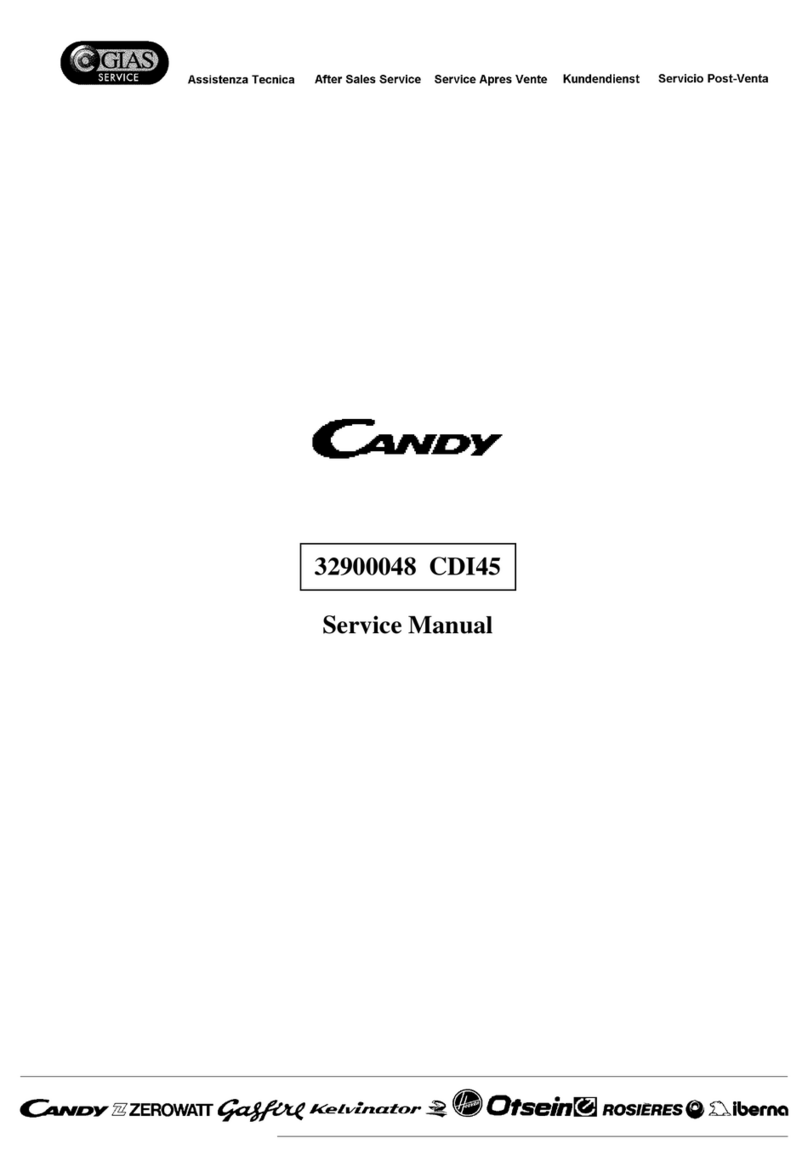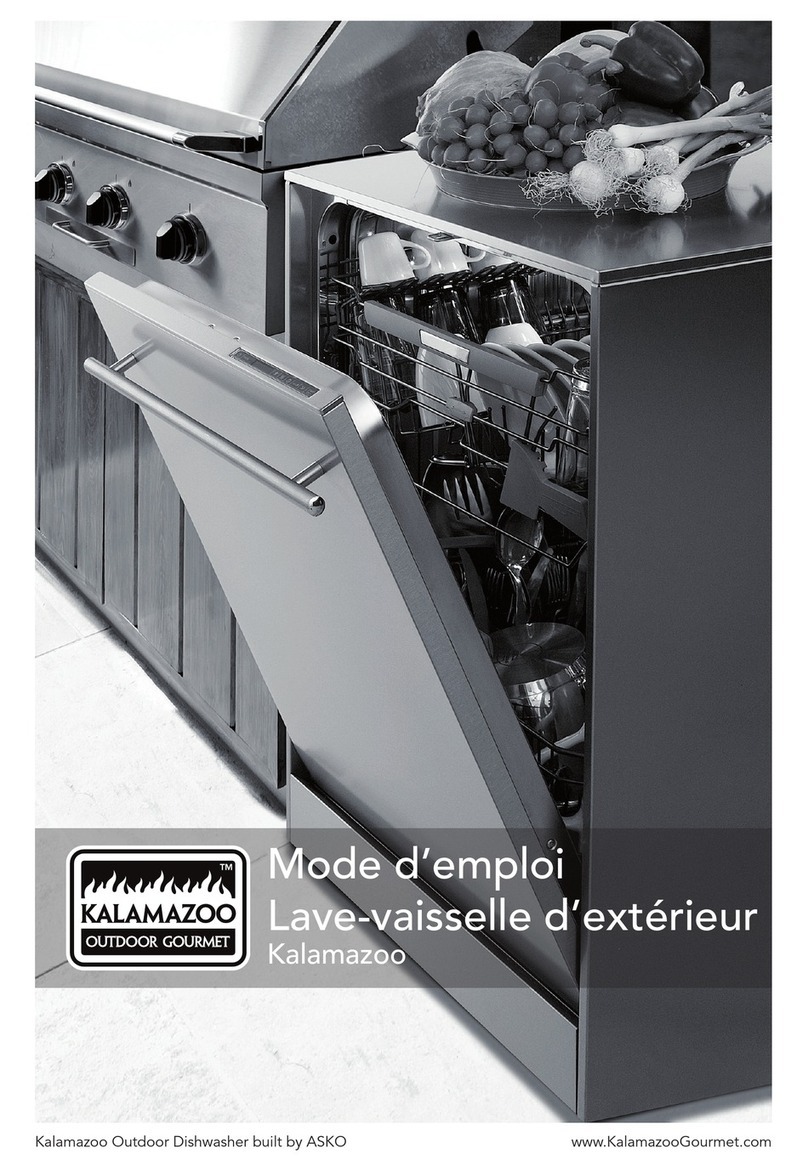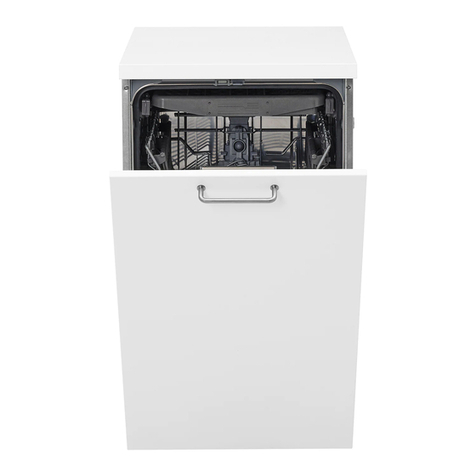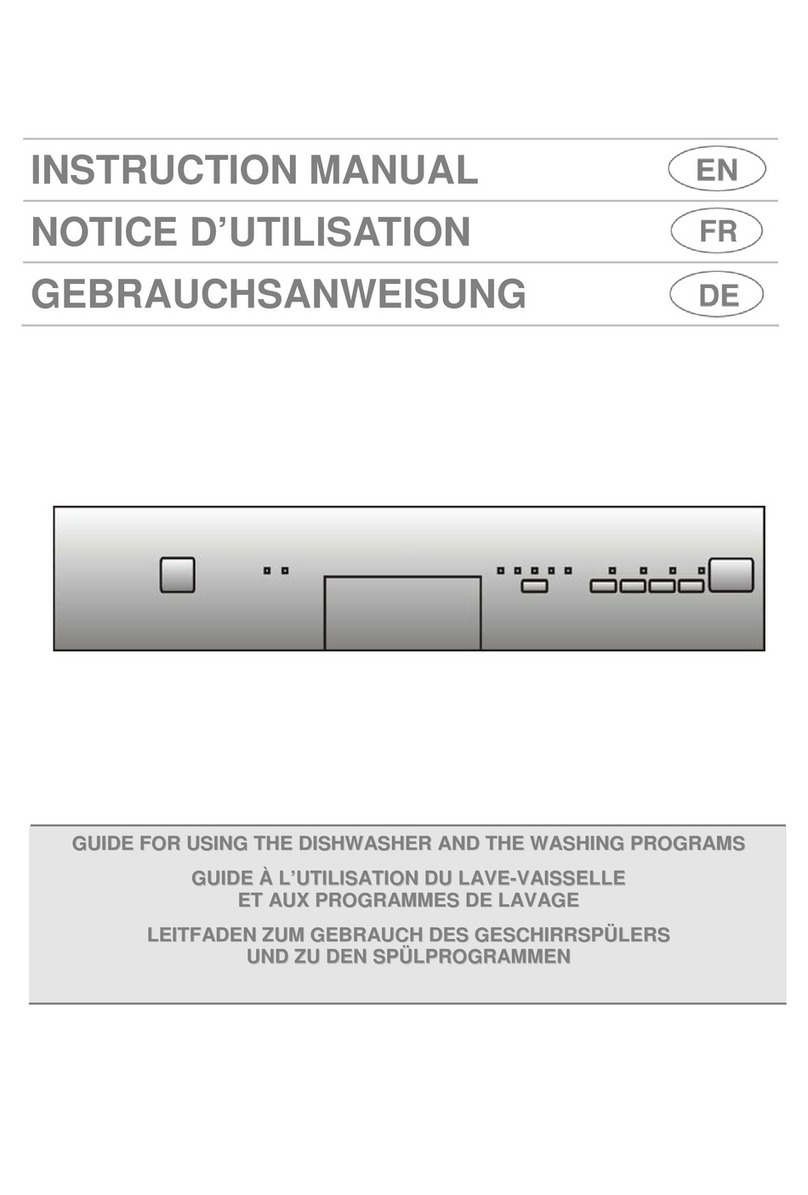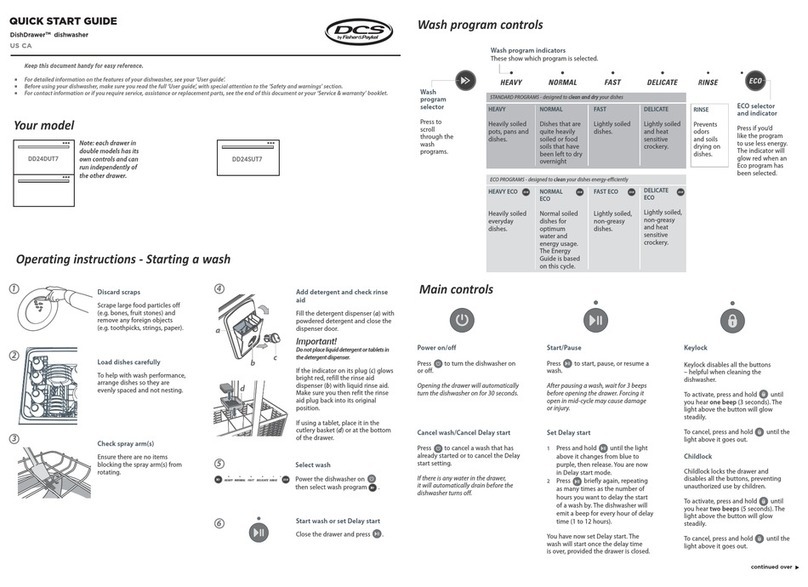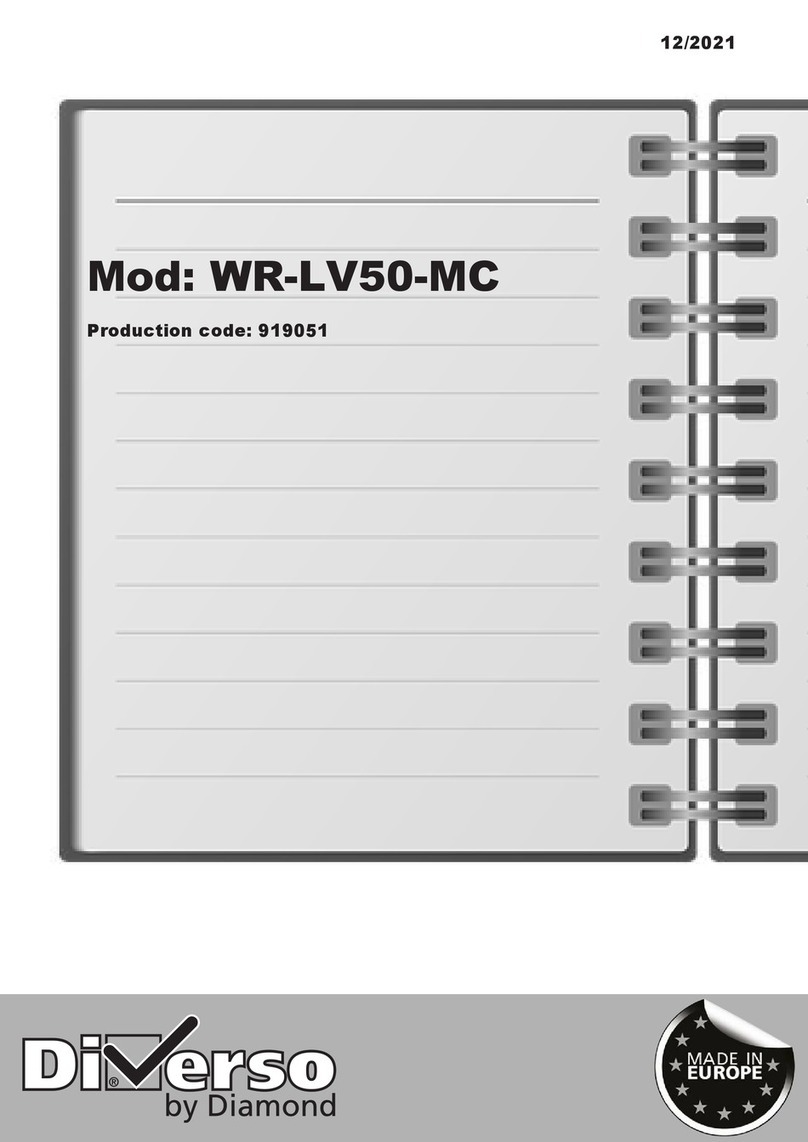NEW POL XD500 Manual

461304317
18/10/02
Litograf s.r.l. Jesi

R R
R
R R
R
R R
R R
R
R R
R
R R
R
R R
R
R R
R
R
R R
R
I
LAVASTOVIGLIE
Manuale uso
e manutenzione
DISHWASHER
Use and maintenance
handbook
LAVE-VAISSELLE
Livret d’instructions
et d’entretien
GB
F
LAVAVAJILLAS
Manual de uso y
manutención
E
P
MAQUINA DE LAVAR PRATOS
Manuale de uso
e manutenção

12345678901
12345678901
12345678901
12345678901
12345678901
12345678901
1
GB
BEFORE USING THE APPLIANCE
1
Norms and regulations to be respected
• The dishwasher may only be used to clean household dishes. If the appliance is used for other
purposes or in a wrong manner, the manufacturer declines all responsibilities for possible damages.
• For safety reasons, no modifications must be carried out on the appliance.
• Before connecting the appliance to the electric power supply system, check that the power supply at
the place of installation is compatible with the electric data indicated on the data tag.
• The installation must be carried out by qualified personnel.
Before running the appliance for the first time
• Make sure the dishwasher was not damaged during transport.Do not hook up the appliance if there
is any damage. In case of damage, contact the vendor.
For the safety of children
• Do not allow children to play with the appliance.
• Detergents can cause permanent damage to eyes, mouth and throat.
They should therefore be kept outside the reach of children.
• The water in the dishwasher is not drinkable.Any residues of detergent in the appliance constitute a
source of danger for children.They must therefore be kept away from the open dishwasher.
Daily use
• Do not turn on the dishwasher if the electric cable, or the water supply or water drainage pipes are
damaged, or if the control board, the work surface or the base are in very bad condition.
• In case of a malfunction, shut off the water supply, then turn off the appliance and pull the electric
plugfrom theoutlet.Ifthere isa permanentelectric connection,turn off the serviceswitch(if present)
or remove the fuse (or fuses).
• To remove the plug from the electric outlet, hold the plug itself and pull;never pull the cable.
• Allrepairs ofthe dishwasher mustbe carriedout byspecialised personnel.Inappropriaterepairs can
create a severe danger for the user.For repairs, you should therefore contact our technical customer
assistance service or a specialised vendor.
• The replacement of the supply cable must be carried out only by the technical service staff.
• If the pipes and tubes are deteriorated, substitute them with new original parts before hooking up
the appliance.
• Do not use detergent substances that could lead to an explosion.
• Do not sit or lean on the open door.The appliance might otherwise tilt over.
• Before adding special dishwasher salt, detergent and rinse aid, make sure that the manufacturer of
these substances recommends their use for household dishwashers.
• Always shut off the water supply when the dishwasher is not in use for longer periods of time, e.g.,
during your vacations.
1.1 SAFETY INSTRUCTIONS

1234567890
1
23456789
0
1
23456789
0
1
23456789
0
1
23456789
0
1
23456789
0
1234567890
GB
2
UNPACKING – DISPOSAL
2
Remove the external plastic packaging material, the corner re-enforcements, and the styrofoam base.
Open the door and remove the styrofoam blocks from the inside baskets.
Collect and recycle the packaging materials.This will preserve primary materials and help reduce the
amount of waste.
Take the packaging materials to specialised recycling centres .
Whentheapplianceeventuallyhastobedisposedof,itshould be madenon-functionalbeforeeliminating
it.
Attention! Some packaging materials (e.g., plastic bags, styrofoam) can be
dangerous for children. Children should therefore be kept away from them.
At the end of its life span, the appliance must be eliminated by a specialised company, respecting all
existing laws and regulations.
This will make it possible to dispose of the old appliance while at the same time recuperating and
sorting syntheticmaterialsthat are fitfor recycling,thuscontributingtothe protectionofthe environment.
2.2 FINAL DISPOSAL OF APPLIANCE
2.1 UNPACKING
3.1 WASHING DISHES IN AN ECONOMIC AND ECOLOGICAL WAY
GENERAL ADVICE
3
• Don’t rinse your dishes under running water before placing them in the dishwasher
• Run the appliance only when it is full, because only like this the process becomes economical and
respects the environment.
• Always choose a programme that is adequate for the kind of dishes you want to wash and that
corresponds to how dirty they are
• You should avoid to use too much detergent, dishwasher salt, and rinse aid. Refer to the dosages
recommended in the usage instructions provided by the manufacturers of these substances.
• Make sure that the water softness regulator is set correctly.
3.2 DISHES NOT TO BE WASHED IN THE DISHWASHER
You must not wash in this appliance:
- Cutting boards or small containers in wood
- Plastic objects that are not heat resistant
- Lead crystal
- Objects made from tin or copper
- Dishes or cutlery with glued components
- Old cutlery with heat sensitive glue
- Steel objects that are oxidised easily
- Cutlery with handles in wood, horn, antler, porcelain, or mother of pearl.
When purchasing dishes, cutlery, or glasses, make sure that they are
dishwasher resistant.

12345678901
12345678901
12345678901
12345678901
12345678901
12345678901
3
GB
LA2505-020
1
1
8
9
10
13
4
7
12
14
5
11
3 2
6
DESCRIPTION OF THE APPLIANCE
4
1) salt container
2) rinse aid container
3) container for detergent
4) data tag
5) filters
6) lower spray-rotor
7) upper spray-rotor
8) electric cable
9) water supply tube
10) water drainage tube
11) lower basket
12) upper basket
13) cutlery container
14) hook for door closing mechanism
4.1 GENERAL PARTS
4.2 TECHNICAL DATA
capacity (standard settings): 12
pressure of water supply system
minimum pressure:0.05 Mpa
maximum pressure: 1 Mpa
Attention: the necessary characteristics
of the electric supply grid are indicated
on the data tag.
0,05 - 1MPa Model. ......................
....A
MAX .......W
........V.....Hz
Made in EU
...................
12

1234567890
1
23456789
0
1
23456789
0
1
23456789
0
1
23456789
0
1
23456789
0
1234567890
GB
4
3
5.1 LEVELLING
Place the appliance in the spot where you want to install it.Use feet P (unscrew or screw in) to regulate
(if necessary) the height of each foot to assure that the appliance is in a fully level position.
If the appliance is positioned in a level position, its correct functioning is assured.
Maximum error = 2 degrees
After levelling the appliance, regulate the hook of the door closing mechanism, to assure that the door
closes perfectly.
Inorder toobtain aperfect sealadjust the doorlocking device butonly afterhaving levelledthe machine
in its final installation position.
2
LA2505-030
LA2505-040
INSTALLATION
5
5.2 WATER CONNECTION
The water supply tube C, which accompanies the
dishwasher, makes it possible to connect the appliance
to a faucet with a _” attachment.
During the installation, the following instructions must
be followed:
• Attach tube Cto the cold water faucet A;place filter B
(suppliedwith theappliance)betweentubeand faucet.
• If the tube is being attached to new pipes that have
not been used for a long time, you should let the water
run for some time before attaching the tube in order to
make sure that dirt and rust residues are eliminated.
• Make sure that the water pressure corresponds to the
range indicated on the data tag.
The appliance may be connected to the cold water
system.It must not be connected to the hot water sys-
tem.
A
B
P
C
2.1
M

12345678901
12345678901
12345678901
12345678901
12345678901
12345678901
5
GB
min 32 cm
max 80 cm
4
LA2501-050
5.3 CONNECTION OF DRAINAGE WATER
The curved end of drainage tube T, which is being supplied with your appliance, should be hooked
onto the edge of a sink or into a drainage pipe.
A special siphon should be used to prevent bad odours.
During the assembly, the following precautions should be taken:
- the drainage tube must not be bent to avoid blockages;
- the tube’s end, relative to the top surface of the dishwasher (fig. 4), must be placed at a height
between 32 and 80 cm;
- the end of the tube must never be immersed in water;
- the drainage tube must not be extended to more than a maximum length of 1 metre.The extension
must have the same internal diameter.Furthermore, the maximum height at which the tube’s end
can be placed (in the case of an extended tube) must be reduced from 80 to 50 cm.
- If you use a drainage pipe, make sure its internal diameter is not inferior to 4 cm.
5.4 ELECTRIC CONNECTIONS
The appliance may only be connected to a properly installed electric outlet with
an earth (ground) contact.The connection must be carried out in correspondence
with existing laws and regulations and supplementary rules issued by the supplier
of electric power.
The tension shown on the data tag must correspond to the power tension of the electric
grid at the site of installation.
See data tag for the size and format of the electric outlet to be used.
T
T

1234567890
1
23456789
0
1
23456789
0
1
23456789
0
1
23456789
0
1
23456789
0
1234567890
GB
6
1
USE
6
6.1 BEFORE USING THE APPLIANCE
Before turning on the appliance, make sure that the plug attached to the electric cable is
connected to the electric outlet, the water supply tube is connected to the faucet, the faucet is
turned on, the drainage tube has been connected according to the instructions.
LA2505-070
6
Use only special dishwasher salt. Other types of salt (e.g., regular household salt)
often contain substances that do not dissolve completely in water and can
therefore obstruct the water softener, thus making it unusable.
D
Regulation of the water softener system
For the washing process it is better to use soft water (with a
low calcium content), to avoid calcium deposits on the dishes
and on the inside of the dishwasher. For this reason, the
appliance is equipped with a water softener (fig. 6) which is
automatically regenerated in regular intervals thanks to the
saline solution. The salt consumption for the regeneration
process depends on the hardness/softness of the local water
that is being used.
To find out the degree of hardness of your water contact
your town administration or use a commercial testing kit.
Opening of the door
Pull the handle forward. The door should open without effort. If you pull the handle while the
dishwasher is running, a safety mechanism will turn off the appliance.
Position
of
regulation device
French degrees
˚fH German degrees
˚dH
1
2
3
4
<15
>15 <25
>25 <40
>60 <90
<8,4
>8,4 <14
>14 <22,4
>33,6 <50,4
>=higher/<=lower
LA2505-060
5
L
Adding special dishwasher salt
• Open the door and take out the lower basket
• Remove the lid of the salt container by turning it anti-
clockwise
Onlyduringthefirsttime youcarry out thisoperation:
fill about 1/2 litre of water into the salt container
• Use funnel Lto fill the special dishwasher salt into the
container (use about 1.0-1.5 kg of salt).
• Remove possible salt residues from theopening ofthe
container.
• Put the lid of the container back in its place by turning
it clockwise.
• If you don’t use the dishwasher immediately after fill-
ing the salt container, run the programme
pre-wash
to
rinse awaythewaterand saltparticles that spilled over
from the container.
For safety reasons we recommend to refill the
container after seven wash cycles – always at the
beginning of a cycle.
To guarantee an optimal regeneration of the softener it is
necessary to set device Daccording to your local hardness
(see table) and to make sure that the salt container is always
filled with special dishwasher salt.

12345678901
12345678901
12345678901
12345678901
12345678901
12345678901
7
GB
7
LA2505-080
Refilling of rinse aid
The rinse aid, which is released automatically
during the final phase of the wash cycle,
guarantees that the dishes dry quickly and
prevents the formation of stains and calcium
sediments.
Indication of salt level (if present)
Thegreenmarkunderthe capindicatesthatthere
is still enough salt in the container. If the green
mark isnolonger visible,the saltcontainer needs
to be refilled with special dishwasher salt.
8
9
LA2505-092
LA2505-096
Only use rinse aids for dishwashers. Other products won’t obtain the desired
effect.
The rinse aid container Sis located on the inside
of the door.
•Remove thecontainer capTbyturning it _ revo-
lution anticlockwise.
•Fillcontainer withrinse aidup tothe broken line.
Maximum quantity:about 140 ml.
•Put the cap back in its place.
•Clean off possible residues of rinse aid with a
cloth, otherwise too much foam might be pro-
duced during the rinsing process.
Indication of rinse aid level
More rinse aid needs to be added when the
indicator(located onthe containerF) isclear ( ).
When the container is full, the indicator has a dark
coloration.
S
T
F

1234567890
1
23456789
0
1
23456789
0
1
23456789
0
1
23456789
0
1
23456789
0
1234567890
GB
8
LA2505-094
Regulation of rinse aid dosage
The regulation Rof the quantity of rinse aid that is
released can be found in the refill opening of the
rinse aid container.
It can be adjusted with a screwdriver.The possible
settings range from 1 to 4. 1 corresponds to a
release of one ml of rinse aid, 4 to four ml, etc.The
appliance has been set on 2 (two ml) by the
manufacturer.
A full rinse aid container is sufficient for about 50
washcycles.Thequantity of rinseaidtobereleased
should be adjusted when the result of the wash
process is not satisfactory.
•Always wipe off with a cloth any rinse aid that
spilled over from the container.
It is important to check the level of rinse aid in
the container periodically – if possible every
31 wash cycles.
Adding the detergent
IMPORTANT! Do not use detergents in this
dishwasher that are made for dish washing by
hand! These substances produce large quantities
of foam but they do not clean the dishes in a
dishwasher.Theycanevenlead toamalfunctioning
of the appliance.
You should therefore only use detergents that are
specifically made for household dishwashers.
Keep your detergent containers closed and in a
dry place.
Only when you use the pre-wash programme no
detergent is needed.
During aprogrammethe detergent isautomatically
taken from the detergent container.
Werecommend theuse of about25 gof detergent.
Detergents vary in their strength and efficiency.
You should therefore pay attention to the
dosage recommendations of each
manufacturer.
The container for the detergent is located on the
inside of the door.
If the lid is closed:
•Push forward closing mechanism P. The lid will
open with a “click”.
•Fill the detergent into the containerV.
•To close the lid, press until you hear a closing
“click”.
If your dishes are exceptionally dirty, you can also
fill some detergent into the indentation of the lid. In
this case, fill the indentation up to the edge. This
detergent will be available and active during the
pre-wash phase.
1
2
3
4
1
2
3
4
LA2505-090
LA2505-100
11
12
10
R
P
V

12345678901
12345678901
12345678901
12345678901
12345678901
12345678901
9
GB
13
LA2505-110
14
LA2505-112
There are two dish baskets that allow you to store
all different kinds of dishes.
•Remove from the dishes any larger pieces of
food to avoid an obstruction of the filter and the
development of bad odours.
•If pots and pans are particularly dirty and con-
taincrustsof food (afterfrying or roasting),soak
them in a water bath before washing them in the
dishwasher.
Use of the lower basket
The lower basket is intended to hold dishes that
are more difficult to clean, as well as the cutlery
basket.
Thelowerbasket holdsregular plates,soup bowls,
pans, soup tureens, lids, and serving dishes.Flat
and deep plates must be placed in a way that
leaves some space between the individual plates.
All plates must be in a vertical position so that the
water can pass freely.
Pansandpotsmustalwaysbeplacedupsidedown.
You can choose any kind of loading configuration,
but you should make sure that the dirtiest surface
of dishes, pots and pants faces the water spray
andthat thewatercan flow off withouthindrances.
Cutlery
For best cleaning results, cutlery should be inserted with its handles facing down.Spoons, forks, and
knifes must be placed in the specific areas of the cutlery basket that are designed for them.
How to load and unload the dishwasher
ATTENTION:
Particularly long cutlery, specifically“long knives”, should not be positioned pointing upwards but
should be placed horizontally in the top tray or washed by hand.

1234567890
1
23456789
0
1
23456789
0
1
23456789
0
1
23456789
0
1
23456789
0
1234567890
GB
10
15
LA2505-120
LA2505-130
LA2505-134 LA2505-132
16
1
2
Use of the upper basket
The upper basket can be pulled out all the way.
It holds small and medium sized dishes such
as glasses, small plates, tea and coffee cups,
smallsalad bowls,and smallpans andpotsthat
arenot very dirty.Desert plates mustalways be
placed vertically;glasses, cups, pots and pants
must be placed upside down. Light dishes
should be held by a support structure so that
they don’t get thrown around by the water jet.
An optimal arrangement of dishes inside the
dishwasherwillguaranteebestwashingresults,
allowing the appliance will be able to develop
its full effectiveness.
Height regulation of the upper basket
Use the handle on the side (only on left) to regulate the
basket’s height and inclination.
1 regulation of horizontal position
2 regulation of inclination
Because of the elevated temperature of the water used to wash the dishes and
of potential chemical reactions with the detergent, it is recommended not to
wash copper or aluminium dishes, cutlery with wood or horn handles, delicate
porcelains, or non heat resistant glass or plastic dishes in the appliance.
If you possess decorated porcelain, you should test one single piece to make
sure that the décor is not being damaged or altered.

12345678901
12345678901
12345678901
12345678901
12345678901
12345678901
11
GB
Start
After checking the quantities of regeneration salt and of rinse aid, open the water faucet completely,
place the dishes in the baskets, fill detergent into the detergent container and add also detergent for
the pre-wash (if necessary); then close the front door.
Now proceed as follows:
•Turn the programme selection dial 4clockwise (fig. 18) until the number of the desired programme
coincides with the line on the dial.
•Press the button on/off.Now the control light should be turned on to indicate that there is a supply of
electricity. The appliance will now automatically perform all steps of the pre-chosen programme.
After the cycle is over, the dishes do not need to be dried by hand- they are being dried automati-
cally.The dishes can now be taken out or can stay inside the dishwasher until they are needed.
Do not open the appliance after a programme has been initiated.
Stop
After the wash cycle, the dishwasher stops automatically, while the electricity control light remains
illuminated. To turn it off, press the button on/off. After each wash cycle, the water faucet must be
closed to insulate the appliance from the water supply system.
Pulling out the upper basket
The upper basket can be pulled out and removed
as shown in the figure.
17
Description of control buttons and
indication lights
1)Control light
It is illuminated when the appliance is turned on.
When the“add salt”light comes on (every 7 cycles), it will continue to be illuminated
throughout the entire cycle, even if salt was added.
When the “add rinse aid”light comes on (every 31 cycles), it will continue to be
illuminated throughout the entire cycle, even if rinse aid was added.
2)Buttons
On/Off –Press this button to turn on the appliance.
Press the button to activate a wash at 45º.
Press the button to activate the SuperWash (special wash for pans).
3)Door handle
To open pull forward (an electric safety mechanism turns off the machine when the
door is being opened).
4)Programme selection dial
It is used to choose a wash programme (see programme table). To select the de-
sired programme, turn the dial clockwise.
SW-SL
LA2505-160
- S
✰
45°-E
-ON/OFF
LA2505-170
4
3
12 12 4
3
LA2505-172
18

1234567890
1
23456789
0
1
23456789
0
1
23456789
0
1
23456789
0
1
23456789
0
1234567890
GB
12
Table of wash programmes (medium model)
Programmes:
Programme
number
R
S
S
S
S
1
1
2
A
A
B
B
Pre-wash
Heavy wash
pans and very
dirty dishes
Heavy wash
regularly dirty
dishes
very dirty dishes
very dirty
delicate dishes
Rinse
Fast wash with
pre-wash
Fast wash
without pre-wash
On
Off
45°- E
SW - SL
SuperWash
BUTTONS
DETERGENT
pre-wash
wash
Dishes
and
degree of dirt:
pansand dishes untilthe next
wash cycle
Very dirty pans and dishes
(except delicate pieces)
Very dirty dishes
(except delicate pieces)
Very dirty dishes
Very dirty dishes
(except delicate pieces)
Pans and dishes
Pans and dishes
Pans and dishes
Pans and dishes
Pans and dishes
Short cold wash to prevent food residues from
drying up and forming crusts on the dishes
1 warm Pre-wash –Main wash
2 rinse (1 cold –1 warm) Drying
1 warm Pre-wash –economy wash
2 rinse (1 cold –1 warm) Drying
1 cold pre-wash –Main wash
2 rinse (1 cold –1 warm) Drying
1 cold pre-wash –economy wash
2 rinse (1 cold –1 warm) Drying
Main wash
2 rinse (1 cold –1 warm) Drying
Economy wash
2 rinse (1 cold –1 warm) Drying
1 cold rinse –1 warm –Drying
1 cold pre-wash –economy wash
2 cold rinse
1 cold pre-wash –main wash
2 cold rinse
Economy wash –2 cold rinse
Main wash –2 cold rinse
Programme
descriptions:
Table of wash programmes (economy model)
Programmes:
Programme
number
R
1
2
3
A
B
Pre-wash
Heavy wash
regularly dirty
dishes
very dirty dishes
Rinse
Fast wash with
pre-wash
Fast wash
without pre-wash
On
Off
BUTTONS
DETERGENT
pre-wash
wash
Dishes
and
degree of dirt:
pansand dishes untilthe next
wash cycle
Very dirty dishes (except
delicate pieces)
Very dirty dishes
Pans and dishes
Pans and dishes
Pans and dishes
Short cold wash to prevent food residues from
drying up and forming crusts on the dishes
1 warm Pre-wash –Main wash
2 rinse (1 cold –1 warm) Drying
Main wash
2 rinse (1 cold –1 warm) Drying
1 cold rinse –1 warm –Drying
1 cold pre-wash –economy wash
2 cold rinse
Main wash –2 cold rinse
Programme
descriptions:

12345678901
12345678901
12345678901
12345678901
12345678901
12345678901
13
GB
7.2 CLEANING OF FILTERS
After each wash the filter group should be checked in order to remove possible dirt residues.Proceed
as follows:
•take out the central filter 1
•remove the external water filter 2
•take out mobile grid 3.
Clean all these components under running water.It is important to clean all filters thoroughly because
the dishwasher cannot function properly with obstructed filters.
We recommend to put the cleaned filters back in their positions immediately to avoid damage to the
wash pump.
LA2505-180
21
LA2505-190
22
LA2505-200
23
23
1
7.3 CLEANING OF THE WATER ENTRY FILTER
You should also clean filter Bperiodically. It is located
between the water faucet and the water entry tube.
•Close water faucet A.
•Unscrew attachment pieceC, take out filter B, and clean
it thoroughly under running water.
•Put the filter back in its place and screw the water entry
hose on.Check that there are no water leaks.
A
B
C
LA2505-040
MAINTENANCE
7
7.1 CLEANING OF SPAY-ROTORS
The spray-rotors can easily be removed for the periodic cleaning of the jets in order to prevent possible
obstructions.
Wash them thoroughly under running water and put them back in their correct position.
LA2505-210
LA2505-220
19 20
To remove the upper spray-rotor:
Unscrewanticlockwisethesupportofthespray-rotor.
To remove the lower spray-rotor:
Pull the spray-rotor upwards and take it out.

1234567890
1
23456789
0
1
23456789
0
1
23456789
0
1
23456789
0
1
23456789
0
1234567890
GB
14
WHAT TO DO IN CASE OF MALFUNCTIONS
8
You should first check whether it is possible to rectify some minor problems yourself. Follow these
instructions. If you are unable to identify or remove the problem, you should contact the technical
client assistance service.
• The programme does not start
- Are the internal fuses broken? Is the dishwasher connected to the electric supply system?
- Is the door closed properly? Press on the door to close it completely.
• No water enters the appliance
- Is the water faucet open?
- Is the filter between the faucet and the water supply tube obstructed? If so, clean the filter.
- Is the water supply tube obstructed? Check the tube.
• The programme indicator does not move on from its starting position
- Is the water faucet completely open?
- Is the filter between the faucet and the water supply tube obstructed? If so, clean the filter.
- Is the water pressure lower than 0.05 Mpa?
• The used water is not removed from the dishwasher
- Is the waste disposal tube obstructed? Check the tube.
- The siphon is obstructed? Check the siphon.
• The dishes are not clean after washing them
- Did you choose an appropriate programme for the type of dishes and the degree of dirt you are
dealing with?
- Are the dishes arranged in a way that allows the water-jet to reach all their surfaces?
- Are the dishwasher’s baskets overloaded?
- Are the spray-rotors blocked by a dish or some cutlery?
- Are all filters at the bottom of the dishwasher clean? Are they all in their correct position?
- Did you add the correct amount of detergent?
- Is the water discharge tube connected properly?
- Is there still any special dishwasher salt in the appropriate container?Without salt the water is not
being softened.
- Was the water softening system adjusted according to the local amount of calcium in the water?
• The dishes do not dry or they remain opaque
- Is there any rinse aid left in the appropriate container?
• Glasses and dishes show the formation of lines,spots,and stains or a shiny blue coloration
- During the rinse process too much rinse aid is being released.Adjust the rinse aid release.
• Glasses and dishes show stains of dried water
- During the rinse process too little rinse aid is being released.Adjust the rinse aid release.
Please note:
The appliance was tested and checked by the manufacturer. As a consequence,you may find
some traces of water inside.These will disappear after the first use.
7.4 CLEANING OF THE DISHWASHER’S EXTERNAL SURFACES
The dishwasher’s surfaces (made of metal, and in the front of plastic) must be cleaned periodically.
Use a clean and soft piece of fabric. Never use acids or abrasive detergents.
If you don’t use the appliance for long periods of time
If the dishwasher is not being used for extended periods of time, you should proceed as follows:
•run the pre-wash programme twice
•remove the electric plug from the outlet
•disconnect the water supply tube
•leave the door slightly open to avoid the formation of bad odours.

12345678901
12345678901
12345678901
12345678901
12345678901
12345678901
15
F
AVANT D’UTILISER L’APPAREIL
1
Utilisation d’après les normes
• La machine à laver la vaisselle doit être utilisée seulement pour le lavage de la vaisselle à usage
domestique.
Si l’appareil est utilisé pour d’autres objectifs ou de façon erronée, la Maison de construction ne
s’assume aucune responsabilité pour des dommages éventuels.
• Pour des motifs de sécurité, aucune transformation ou modification au lave-vaisselle n’est admise
• Avant de brancher l’appareil au réseau électrique, assurez-vous que les données de tension et de
courant indiquées sur la plaque des données correspondent à celles qui sont indiquées à l’endroit
de l’installation.
• L’installation doit être faite par du personnel qualifié.
Opérations préliminaires lors de la première mise en marche
• Contrôlez si le lave-vaisselle a subi des dégâts éventuels durant le transport.Dans tous les cas, ne
branchez pas l’appareil endommagé.En cas de dégâts, adressez-vous à votre fournisseur.
Pour la sécurité des enfants
• Ne permettez pas aux enfants de jouer avec l’appareil.
• Les produits détersifs peuvent causer des dommages irréparables au yeux, à la bouche et à la
gorge.
Garder donc les détersifs hors de la portée des enfants.
• L’eau dans le lave-vaisselle n’est pas potable.Tant qu’il y a encore des restes de détergents dans la
machine, c’est un danger pour les enfants qui doivent s’éloigner du lave-vaisselle ouvert.
Pour le fonctionnement quotidien
• Nemettezjamaisen marchelelave-vaissellesile câbleducourant,lestuyaux d’entrée etd’évacuation
de l’eau sont endommagés ou si le tableau des commandes, le dessus de la machine ou le socle
sont très détériorés.
• En cas de panne, fermez avant tout le robinet de l’eau, éteignez l’appareil et enlevez la fiche de la
prise de courant.En cas de connexion fixe, débranchez éventuellement l’interrupteur de service ou
enlevez le fusible (ou les fusibles).
• Pour ôter la fiche de la prise de courant, saisissez la fiche par le corps et jamais par le câble.
• Lesréparationsdelamachineà laverlavaisselledoiventêtreeffectuéesseulementpardes personnes
spécialisées.Des réparations non appropriées peuvent mettre l’utilisateur en grave danger.En cas
de réparations, adressez-vous donc à notre service technique assistance clients ou à votre reven-
deur spécialisé.
• Le remplacement du câble d’alimentation doit être effectué seulement par le personnel du service
assistance technique.
• Encasde détériorationdestuyaux, pourleraccordementdel’appareil,ceux-ci doivent êtreremplacés
par des tuyaux originaux.
• N’introduisez pas de substances dissolvantes qui pourraient provoquer une explosion dans le lave-
vaisselle.
• Ne vous asseyez pas et ne vous appuyez pas sur la porte ouverte:la machine pourrait se renverser.
• Avant d’introduire le sel spécial, le détersif et le liquide de rinçage, assurez-vous que le producteur
de ces substances recommande leur utilisation pour les machines à laver la vaisselle à usage
domestique.
• Fermez toujours le robinet de l’eau si vous n’utilisez pas le lave-vaisselle pendant quelque temps,
par exemple durant les vacances.
1.1 INSTRUCTIONS DE SECURITE

1234567890
1
23456789
0
1
23456789
0
1
23456789
0
1
23456789
0
1
23456789
0
1234567890
F
16
DEBALLAGE- TRAITEMENT DES ORDURES
2
Enlevez l’emballage externe en plastique, les coins renforcés et les bases en polystyrène.
Ouvrez la porte et enlevez les pièces de polystyrène des paniers.
La récupération et le recyclage du matériel d’emballage contribuent à économiser les matières
premières et à diminuer le volume des ordures.
Livrez l’emballage à la décharge pour la récupération des matériaux recyclables.
Quand un jour l’appareil devra être mis définitivement hors d’usage, rendez-le inutilisable avant son
élimination.
ATTENTION! Le matériel de l’emballage (par ex. des sacs en plastique,
polystyrène ) peut représenter une source de danger pour les enfants; pour
cette raison, il faut le mettre hors de leur portée.
Quand la machine ne fonctionne plus, elle doit être mise au rebut par des maisons spécialisées, en
respectant les règles en vigueur.
De cette façon, en éliminant un vieil appareil il est possible d’effectuer la récupération différenciée
des matériaux synthétiques destinés au recyclage, pour respecter l’environnement.
2.2 TRAITEMENT DES ORDURES – APPAREIL A METTRE AU REBUT
2.1 DEBALLAGE
3.1 LAVER DE FAÇON ECONOMIQUE ET ECOLOGIQUE
APERÇUS GENERAUX
3
• Ne lavez pas la vaisselle avant sous l’eau courante.
• Utilisez le lave-vaisselle toujours bien rempli, puisqu’il est possible seulement ainsi d’effectuer un
lavage économique et dans le respect pour l’environnement.
• Sélectionnez toujours un programme de lavage correspondant au type de vaisselle et à leur degré
de saleté.
• Evitez absolument des dosages trop abondants de détersif, de sel spécial et de liquide de rinçage.
Faites attention aux doses recommandées dans le mode d’emploi et dans les indications de la
Maison de production de ces substances.
• Vérifiez si le dispositif adoucisseur de l’eau est réglé correctement.
3.2 VAISSELLE NON APPROPRIEE
Ne sont pas appropriés au lavage dans le lave-vaisselle:
- les planches à hacher ou les petits plateaux en bois
- les objets en matière plastique non résistant à la chaleur
- le cristal au plomb
- les objets en étain ou en cuivre
- la vaisselle ou les services ayant des parties collées
- les services plutôt vieux, dont la colle est sensible à la chaleur
- les objets en acier qui s’oxydent facilement
- les services aux manches en bois, en corne, en porcelaine ou en nacre.
Au moment de l’achat de vaisselle, de verres et de services, assurez-vous qu’ils sont appropriés pour
le lavage dans le lave-vaisselle.
Au moment de l’achat de vaisselle, de verres et de services, assurez-vous
qu’ils sont appropriés pour le lavage dans le lave-vaisselle.

12345678901
12345678901
12345678901
12345678901
12345678901
12345678901
17
F
DESCRIPTION DE LA MACHINE
4
1) Réservoir pour le sel
2) Réservoir pour le liquide de rinçage
3) Distributeur de détergent
4) Plaque des données
5) Filtres
6) Bras d’irroration tournant inférieur
7) Bras d’irroration tournant supérieur
8) Câble alimentation électrique
9) Tuyau alimentation eau
10) Tuyau d’écoulement
11) Panier inférieur
12) Panier supérieur
13) Récipient services
14) Crochet fermeture porte
4.2 DONNEES TECHNIQUES
LA2505-020
4.1 VUE GENERALE
1
Capacité ( selon nombre couverts standard ) : 12
Pression dans l’installation hydraulique
pression minimum: 0,05 MPa
pression maximum: 1 MPa
ATTENTION: les caractéristiques
électriques sont indiquées sur la plaque
des données.
1
8
9
10
13
4
7
12
14
5
11
3 2
6
0,05 - 1MPa Model. ......................
....A
MAX .......W
........V.....Hz
Made in EU
...................
12

1234567890
1
23456789
0
1
23456789
0
1
23456789
0
1
23456789
0
1
23456789
0
1234567890
F
18
3
5.1 NIVELLEMENT
Quand l’appareil est placé à son endroit d’installation, réglez les petits pieds P en les vissant ou
dévissant, si nécessaire, pour trouver la même hauteur
de la machine et le même niveau.
Un bon nivellement assure le fonctionnement correct du lave-vaisselle.
Ecart max=2 degrés
Après que la machine a été nivelée, régler en outre le crochet fermeture porte de sorte que celle-ci se
ferme parfaitement.
Une fois l’appareil mis à niveau, règler la gache de fermeture de porte pour obtenir une fermeture
parfaite.
2
LA2505-030
LA2505-040
INSTALLATION
5
5.2 RACCORDEMENT HYDRAULIQUE
Le tube d’entrée eau C, fourni avec l’appareil permet le
raccordement à un robinet avec raccord 3/4”.
Durantle montage,vousdevezrespecter les instructions
suivantes:
• vissez le tube C au robinet de l’eau froide A en
interposant le filtre B fourni avec l’appareil.
• si le raccordement est effectué avec une tuyauterie
qui est utilisée depuis longtemps, on conseille de
laissercoulerl’eau avant de raccorderletuyaud’entrée
del’eauafind’éliminerles dépôts derouilleetdesaleté;
• assurez-vous que la pression dans l’installation
hydraulique estdans lesvaleurs limite indiquéesdans
les données techniques.
Le lave-vaisselle peut être relié à la conduite de l’eau
froide, mais jamais à celle de l’eau chaude.
A
B
P
C
2.1
M
This manual suits for next models
1
Table of contents
Languages:
Other NEW POL Dishwasher manuals
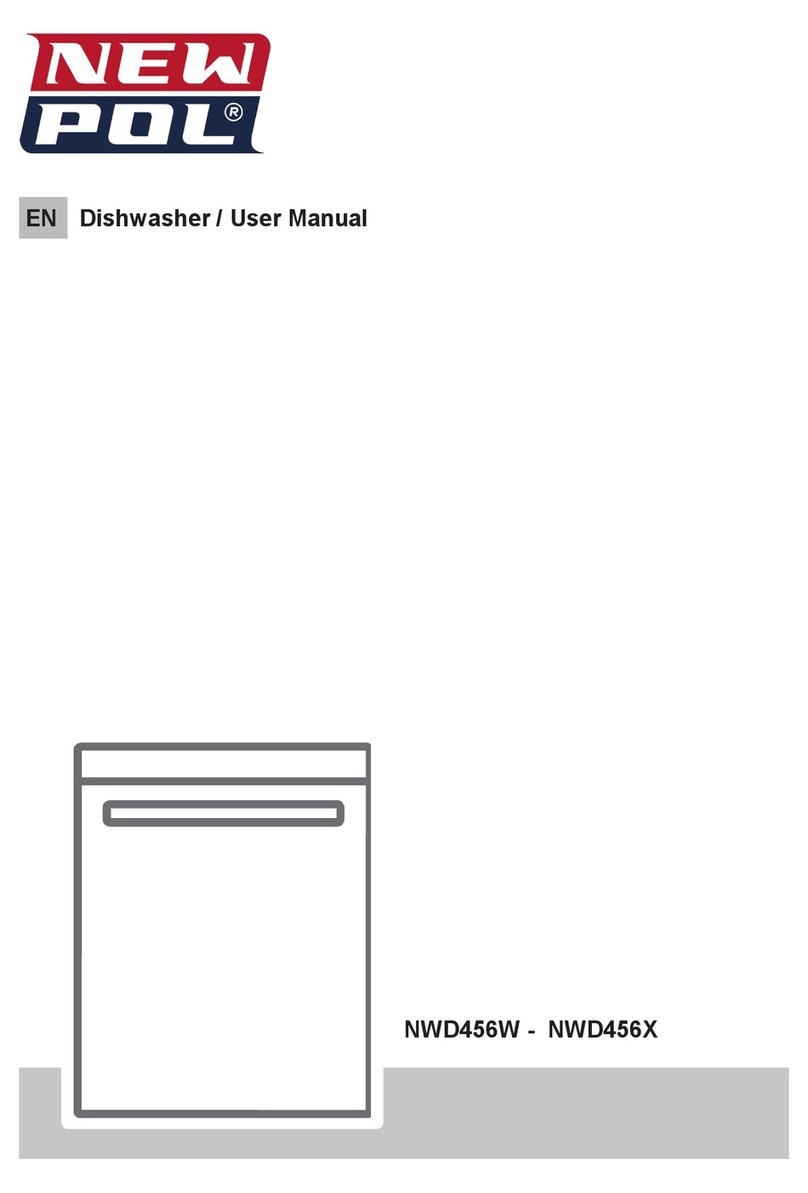
NEW POL
NEW POL NWD456X User manual
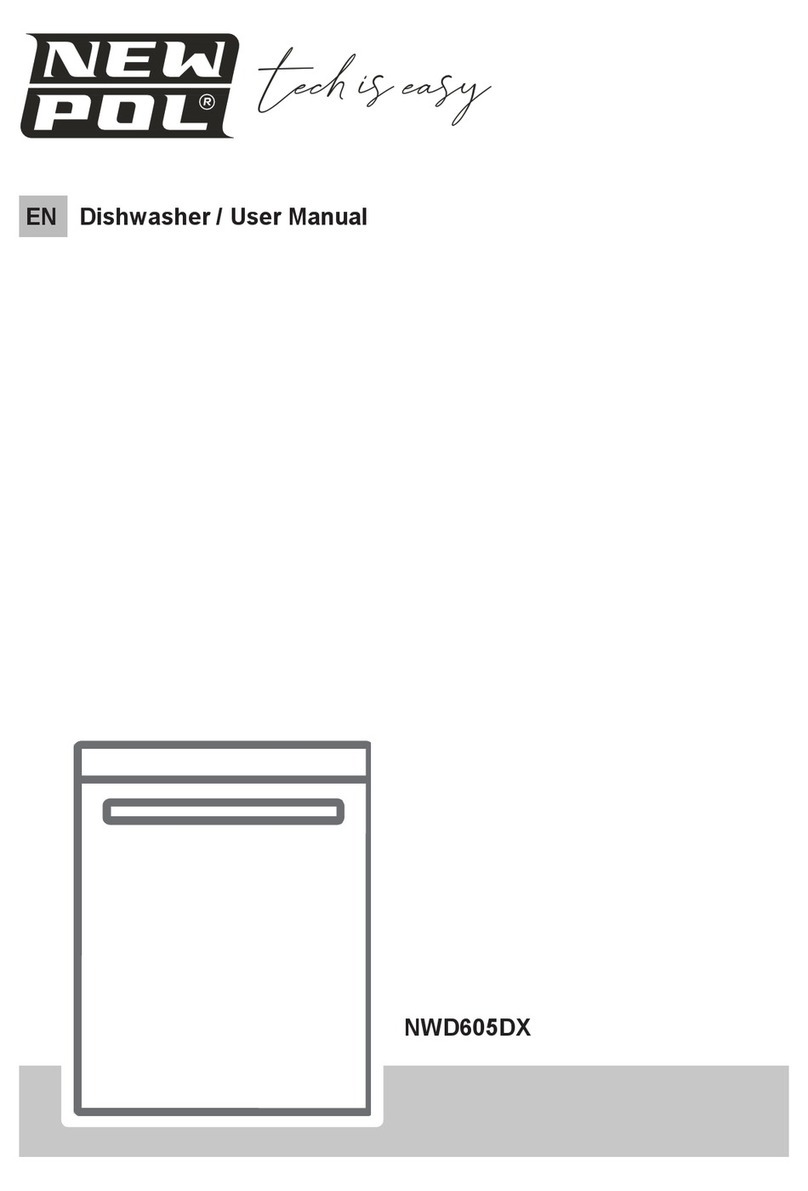
NEW POL
NEW POL NWD605DX User manual
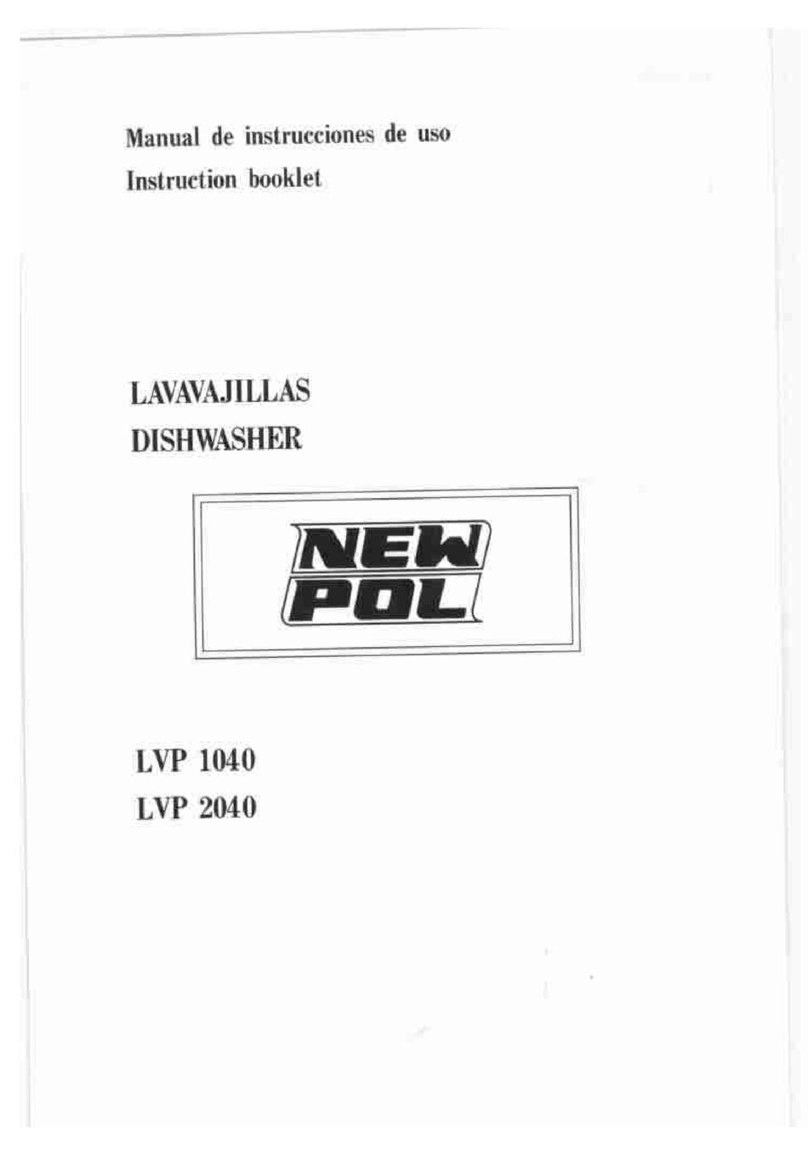
NEW POL
NEW POL LVP1040 User manual
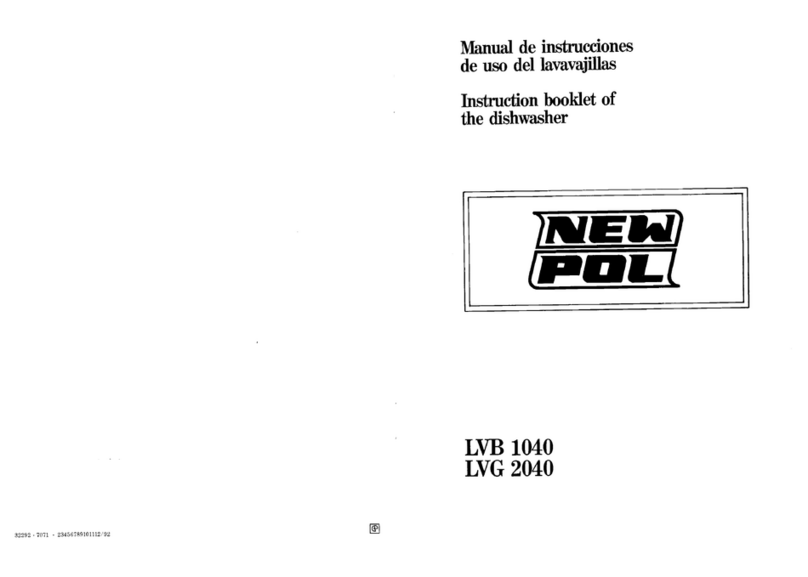
NEW POL
NEW POL LVG 2040 User manual
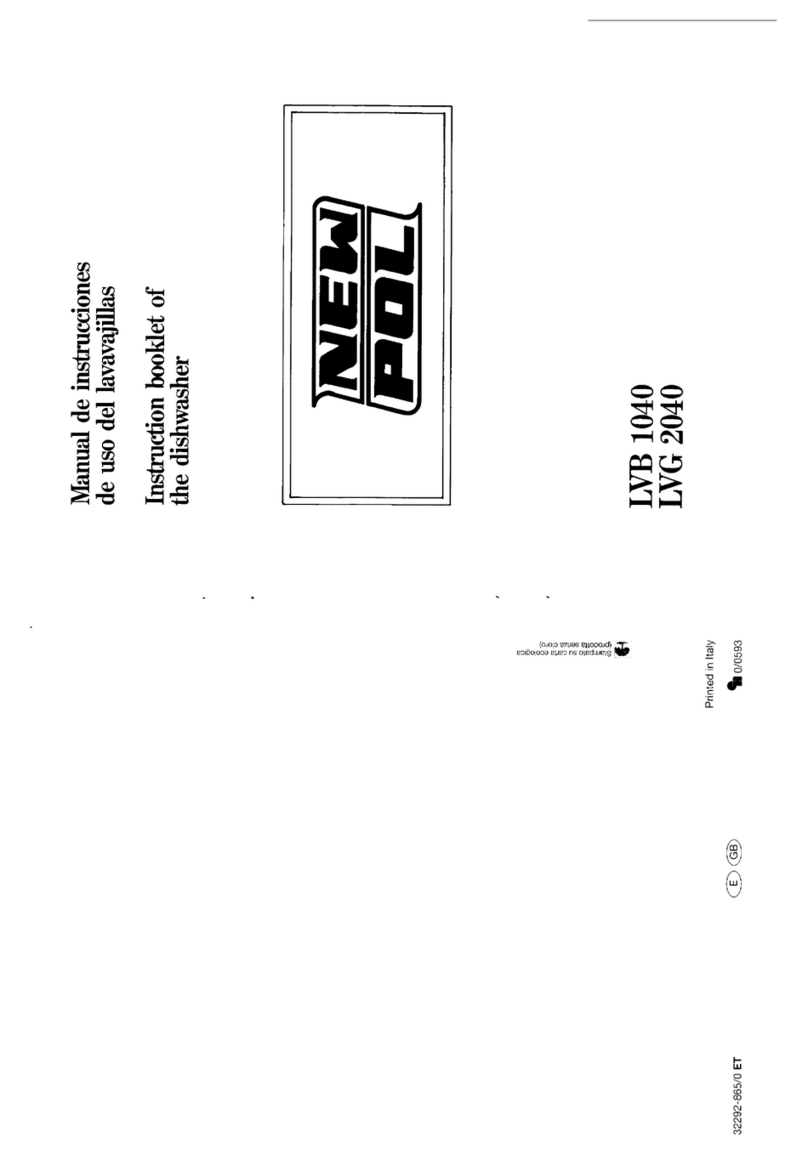
NEW POL
NEW POL LVB 1040 User manual

NEW POL
NEW POL NW3605DX User manual

NEW POL
NEW POL NW605DX User manual

NEW POL
NEW POL NW456W User manual

NEW POL
NEW POL NWD3606DX User manual
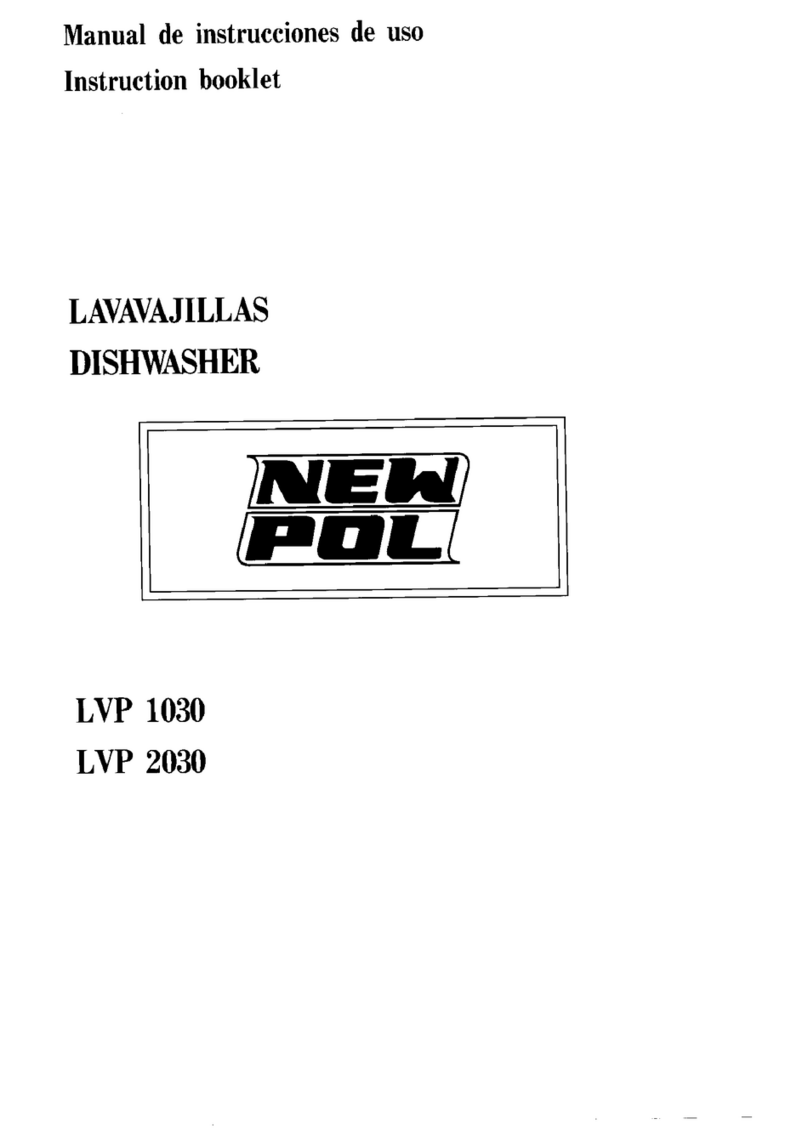
NEW POL
NEW POL LVP 1030 User manual
